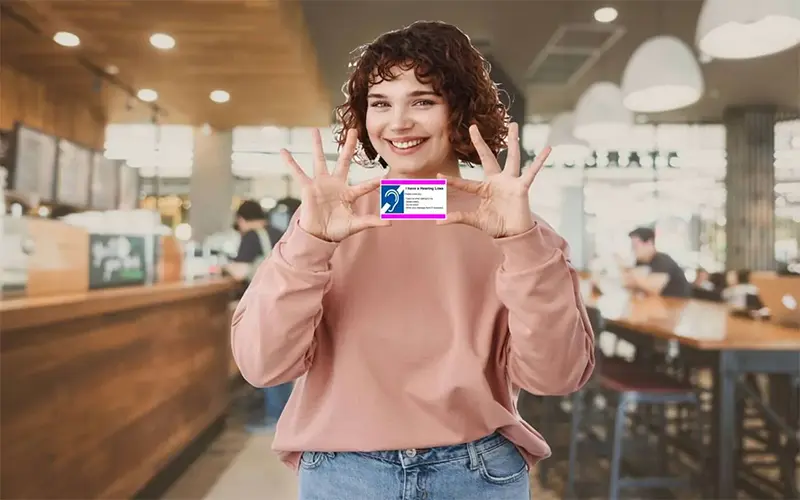For many people with hearing loss, everyday conversations can be stressful. A simple hearing loss card politely lets others know you may need clearer speech, a slower pace, or visual support—making interactions smoother in shops, public transport, workplaces, and healthcare settings. In this guide, we’ll explore exactly what they are, why they matter, where to use them, and how to design one that works for you.
What Are Hearing Loss Cards?
Hearing loss cards are small, wallet-sized cards—often made from durable PVC—that discreetly communicate your hearing impairment. They typically contain a short statement, such as “I have hearing loss; please speak clearly and face me,” sometimes alongside icons for deaf awareness or accessibility. The aim is to reduce the need to repeatedly explain your needs, especially in noisy or stressful environments.
Some cards are generic, while others are personalised with your name, preferred communication methods, or emergency contact details. At SecureID Print Ltd, we can produce custom hearing loss cards to match your preferences—single or double-sided, with optional lanyards and card holders.
Why They Matter for Better Communication
Everyday communication relies heavily on spoken words, facial expressions, and non-verbal cues. When you have hearing loss, some of these cues can be harder to catch—especially in environments with poor acoustics or background noise.
A hearing loss card immediately sets expectations for the conversation. It encourages the other person to:
- Speak clearly and at a steady pace
- Face you when talking, so lip-reading is possible
- Minimise background noise where possible
- Use written notes or text if needed
This small act of communication can transform a rushed, confusing interaction into one that is respectful and effective—improving both understanding and confidence.
Who Can Benefit From Hearing Loss Cards?
These cards are useful for a wide range of people, including:
- Individuals with partial or profound hearing loss
- People with temporary hearing difficulties due to illness or injury
- Those who use hearing aids or cochlear implants
- People with auditory processing disorders
- Older adults with age-related hearing decline
Even if you usually communicate well in quiet environments, noisy settings like train stations, airports, and crowded offices can make a card invaluable.
Where to Use Hearing Loss Cards
A hearing loss card is useful in almost any public or semi-public interaction. Common scenarios include:
- Retail counters and restaurants — Ensures staff speak clearly when taking your order or answering questions.
- Healthcare settings — At GP surgeries, pharmacies, hospitals, and opticians, where clear communication is essential for your safety.
- Public transport — Ticket desks, station announcements, or travel assistance desks.
- Workplaces — Meetings, training sessions, or interactions with clients.
- Events and conferences — Where background noise and fast-paced networking make communication harder.
What to Include on a Hearing Loss Card
Your card should be concise but informative. Most people include:
- A clear statement (e.g., “I have hearing loss; please speak clearly and face me”)
- Preferred communication method (text, lip-reading, captions)
- Optional icons for accessibility or deaf awareness
- Emergency contact information (optional)
- Simple, bold typography for readability
Avoid including sensitive personal data unless absolutely necessary.
Design & Durability Tips
If your card wears out quickly, it becomes less reliable. To make it last:
- Choose PVC for strength and waterproofing
- Use high-contrast colours for better visibility
- Pick a readable font size
- Consider protective overlays or lamination
- Opt for double-sided printing if you have multiple notes or instructions
At SecureID Print Ltd, we offer optional UV panels and holographic laminate for added security and longevity.
Privacy & Dignity
Not everyone wants to verbally declare their invisible disability to strangers. Hearing loss cards provide a discreet, polite way to communicate your needs without unnecessary attention.
They also help in situations where you might feel rushed or anxious—making it easier to advocate for yourself.
How to Order Hearing Loss Cards
SecureID Print Ltd offers:
- Single or double-sided cards
- Customisable designs
- Optional lanyards and holders
- Durable PVC printing
- Security features like UV panel and holographic overlays
Order your hearing loss card here or contact us for bulk and organisational orders.
Frequently Asked Questions
Are hearing loss cards official? No, they are not issued by the government, but they are widely recognised and respected in customer service, healthcare, and travel settings.
Will they help in emergencies? Yes, they can quickly alert first responders or bystanders to adjust their communication methods.
Do I need to show ID with them? Not usually, but it depends on the setting.
Can they be used with other accessibility tools? Absolutely—combine them with apps, note-taking tools, or speech-to-text devices for maximum support.
Can I get them branded for an organisation? Yes—ideal for care homes, hearing charities, and support groups.
Conclusion
Hearing loss cards are a small but powerful tool for improving communication, reducing stress, and ensuring dignity in daily life. Whether you have mild hearing loss or profound deafness, they can make everyday interactions smoother, more respectful, and more effective.
At SecureID Print Ltd, we are committed to helping you design the perfect card for your needs—durable, clear, and discreet. Get in touch today to discuss your requirements or order directly through our website.
